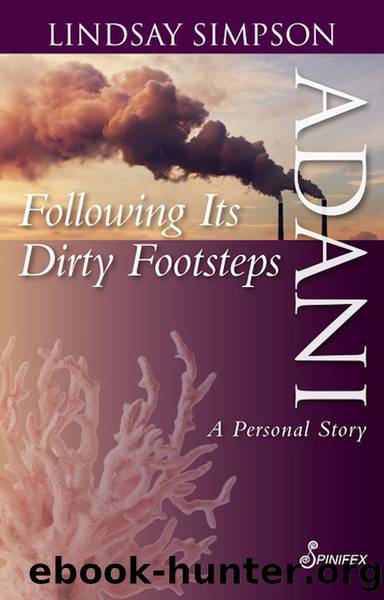Adani, Following Its Dirty Footsteps: A Personal Story by Lindsay Simpson

Author:Lindsay Simpson [Simpson, Lindsay]
Language: eng
Format: epub
ISBN: 9781925581478
Google: 04oOugEACAAJ
Goodreads: 39305673
Publisher: Spinifex Press
Published: 2018-11-01T00:00:00+00:00
The talk around the table with the environmentalists turns to Indiaâs position on climate change. Imogen Zethoven asks the group about Indiaâs role in the Paris agreement and what its post-2020 climate change actions will be.
âDoes India have an INDC? (Intended Nationally Determined Contribution)?â she asks.
âIndia,â Dutta explains, âhas used its status as a developing nation to not accept a limit on peak emissions. When the emissions do peak, India does not accept a deadline to stop or limit emissions.â
So effectively, I am thinking, as one of the major polluting nations, India appears to pay little regard to the Paris agreement ⦠but then to be fair, nor does Australia.
The group is scathing about the social impact on the villages around Mundra from the aggressive expansion of the power plants.
âBoth Adani and Tata brought in large number of migrant workers when the power plants were being constructed â a phase which goes on for four years. 90% of the workers were migrants.â
The group estimates that there were as many as 8000 to 9000 migrant workers from Odisha and other states who flooded Mundra and its surrounding villages and a large number of them were semi-skilled. According to Sazina Bhimaniâs 2014 thesis, there was a 57.21% decadal growth in population in the Mundra town attributed directly to industrialisation of the area through the large number of immigrants attracted by employment prospects.
âAs a result, alcohol consumption and other social ills â family violence against women and children â have gone up. The number of police raids and seizure of alcohol has gone up,â Dutta said. (Gujarat is a âdryâ state.)
And, of course, there are the hidden costs of environmental pollution. They say that both the Tata Mundra and Adani Mundra power plants consume about 29 to 30 million tonnes of coal per year.
âIf you have to wash 30 million tonnes of coal and put that water into the Gulf of Kutch â itâs an enclosed gulf, itâs not an open sea â what does it do with all that coal ash in that small area? Fishing has been devastated.
âParticulate emissions from power plants contain heavy metals, as well as all sorts of other pollutants including toxic volatile organic compounds and sulphur dioxide. Coal-fired power plants are a major source of particulate matter,â says Dutta. âTataâs have better filters in place.
âTata is trying to project a better image. Adani doesnât care much. Adani is far more ruthless.â
Apart from the debate about the effects of the proposed Carmichael mine in India, there has also been plenty of discussion about the effects of the mine on existing Australian coal mines. An article in the ABC in July 2017146 cited research from global resource analytics company, Wood Mackenzie, which pointed out that while both the Federal and Queensland Governments were stressing the economic benefits of new mines in the Surat and Galilee basins, it would come at âa severe cost to jobs and economies in other regionsâ including ten new mining projects in NSW being displaced;
Download
This site does not store any files on its server. We only index and link to content provided by other sites. Please contact the content providers to delete copyright contents if any and email us, we'll remove relevant links or contents immediately.
The Secret History by Donna Tartt(18951)
The Social Justice Warrior Handbook by Lisa De Pasquale(12170)
Thirteen Reasons Why by Jay Asher(8849)
This Is How You Lose Her by Junot Diaz(6839)
Weapons of Math Destruction by Cathy O'Neil(6221)
Zero to One by Peter Thiel(5736)
Beartown by Fredrik Backman(5683)
The Myth of the Strong Leader by Archie Brown(5463)
The Fire Next Time by James Baldwin(5390)
How Democracies Die by Steven Levitsky & Daniel Ziblatt(5175)
Promise Me, Dad by Joe Biden(5117)
Stone's Rules by Roger Stone(5055)
A Higher Loyalty: Truth, Lies, and Leadership by James Comey(4909)
100 Deadly Skills by Clint Emerson(4883)
Rise and Kill First by Ronen Bergman(4741)
Secrecy World by Jake Bernstein(4703)
The David Icke Guide to the Global Conspiracy (and how to end it) by David Icke(4659)
The Farm by Tom Rob Smith(4468)
The Doomsday Machine by Daniel Ellsberg(4452)
